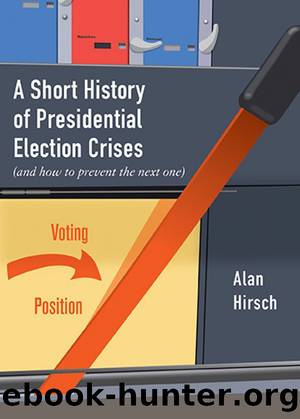A Short History of Presidential Election Crises by Alan Hirsch

Author:Alan Hirsch
Language: eng
Format: epub
Publisher: City Lights Publishers
SIX
THE ELECTORAL COLLEGE: A RECIPE FOR FRAUD AND CHAOS
The presidential election crises in 1800, 1824, 1876, and 2000 each resulted from its own set of causes. The 1800 fiasco resulted from a quirk in the Constitution that produced a tie between running mates, the 1824 crisis stemmed from multiple viable candidates, and the 1876 donnybrook came about due to negligence and corruption. In 2000, the stars aligned perversely: The election hinged on a virtual tie in a state with poor voting machinery and convoluted recount procedures, among other problems. These various election disputes were also resolved through different means: in 1800 and 1824, by the House of Representatives; in 1876, by an ad hoc commission; and in 2000 by the United States Supreme Court.143 Historians debate whether these outcomes were legitimate, but, with the exception of 1800, each outcome undeniably left the losing party feeling robbed.
The other presidential election we have considered, that of 2016, produced a potential crisis stemming from yet another source—covert foreign operations designed to assist one candidate. Though crisis was averted, because (unlike in the aforementioned elections) one candidate clearly received the most electoral votes and there was no evidence of vote tampering, here too the losing candidate and her supporters were understandably chagrined by the circumstances surrounding her defeat.
One other common thread runs through these disparate elections: In each, the crisis—or potential crisis, in the case of 2016—stemmed in part from the Electoral College, a result not entirely unforeseeable. Whatever virtues the Electoral College may have (as discussed below), it does not assure an orderly election. In a piece written just before Election Day in 2000, Professor Akhil Amar prophetically remarked on the “outside chance of a constitutional meltdown in the days ahead.”144 Amar did not have in mind a virtual tie (followed by a battle royale over recounts) but rather an actual tie—each candidate receiving 269 electoral votes.145 Still, if Amar narrowly missed prophesying the precise crisis that was days away, he nailed the larger point: Severe potential problems may arise from “the Constitution’s archaic and confusing rules concerning the Electoral College.”146
The most common complaint about the Electoral College is its risk of negating the votes of millions of American citizens, and installing a person as president who receives fewer votes than his or her opponent. In four elections discussed earlier—1824, 1876, 2000, 2016—the candidate who won the presidency lost the popular vote, an event that also occurred in 1888. This fact alone delegitimized these five elections in the eyes of many, although the risk of a divergence between the popular vote and Electoral College vote had once seemed too improbable to be terribly worrisome. (In that sense, the “wrong winner” was akin to the “faithless elector” who ignores the vote in their own state—a theoretical problem not worth fretting over.) The fact that the Electoral College winner lost the popular vote twice in the last five elections gives the discussion more urgency. And it must not be thought that 2000 and 2016 were fluky.
Download
This site does not store any files on its server. We only index and link to content provided by other sites. Please contact the content providers to delete copyright contents if any and email us, we'll remove relevant links or contents immediately.
The Secret History by Donna Tartt(16606)
The Social Justice Warrior Handbook by Lisa De Pasquale(11485)
Thirteen Reasons Why by Jay Asher(7779)
This Is How You Lose Her by Junot Diaz(5753)
Weapons of Math Destruction by Cathy O'Neil(5027)
Zero to One by Peter Thiel(4816)
The Myth of the Strong Leader by Archie Brown(4785)
Promise Me, Dad by Joe Biden(4439)
Stone's Rules by Roger Stone(4412)
Beartown by Fredrik Backman(4401)
How Democracies Die by Steven Levitsky & Daniel Ziblatt(4392)
The Fire Next Time by James Baldwin(4336)
100 Deadly Skills by Clint Emerson(4070)
A Higher Loyalty: Truth, Lies, and Leadership by James Comey(4024)
Rise and Kill First by Ronen Bergman(4008)
The David Icke Guide to the Global Conspiracy (and how to end it) by David Icke(3875)
The Farm by Tom Rob Smith(3869)
Secrecy World by Jake Bernstein(3773)
The Doomsday Machine by Daniel Ellsberg(3725)
